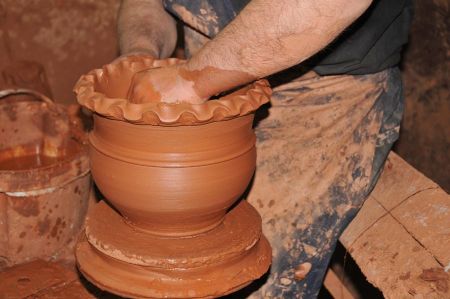Project: Invitation to the Menemen Potters Association
- Written by Portal Editor
As a result of the releases of our Roman Roads project tour calendar, we had received an invitation from the Potters' Association to go to Menemen, a town well known to us by name on the route between Izmir and Canakkale.
In fact, we didn't really know anything about this place and its importance and history, except that Menemen is also the name of a delicious breakfast dish with eggs from the pan that can be described as typical of the country.
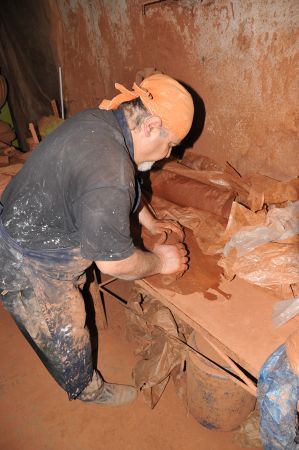 On Saturday noon we left our camping site in Güzelbahce and drove about 40 kilometres to Menemen on the 6-lane highway, passing the city juggernaut of Izmir, then along the wetlands of Sasalı, so well-known among bird watchers.
On Saturday noon we left our camping site in Güzelbahce and drove about 40 kilometres to Menemen on the 6-lane highway, passing the city juggernaut of Izmir, then along the wetlands of Sasalı, so well-known among bird watchers.
A little later we reached Menemen, where the president of the local pottery association, Mr. Ertan Saruhan, was already waiting for us at one of the huge pottery workshops.
It was a warm welcome, which continued to deepen over the course of the afternoon after the first tour of the huge factory had taken place and the first two pottery masters had also demonstrated their art.
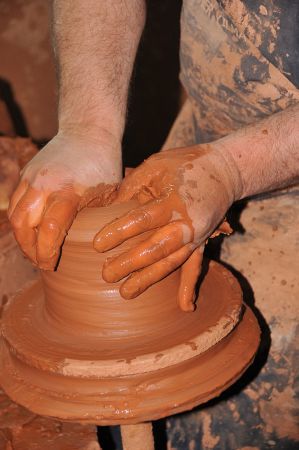 A tangle of Turkish, English and German was spoken, especially since one of the two pottery masters had lived in Dortmund for years. So it was not only about the pottery craft, about which we should learn a lot of details. First of all, we admired the craftsmanship of the two masters, who quickly and skilfully conjured up a flower pot from the natural earth material clay and loam, then an antique-looking amphora and a long-necked flower vase. Decorations and patterns were quickly designed and handles were attached to the amphora.
A tangle of Turkish, English and German was spoken, especially since one of the two pottery masters had lived in Dortmund for years. So it was not only about the pottery craft, about which we should learn a lot of details. First of all, we admired the craftsmanship of the two masters, who quickly and skilfully conjured up a flower pot from the natural earth material clay and loam, then an antique-looking amphora and a long-necked flower vase. Decorations and patterns were quickly designed and handles were attached to the amphora.
The processing of clay and loam and the subsequent firing of the so-called earthenware are probably the first crafts that are closely related to the emergence of human culture. Both the craft and the art of pottery, as the oldest method of making vessels, objects of plastic shaping of a natural material, have retained their importance for centuries. However, the artistically working masters today see themselves more as ceramists.
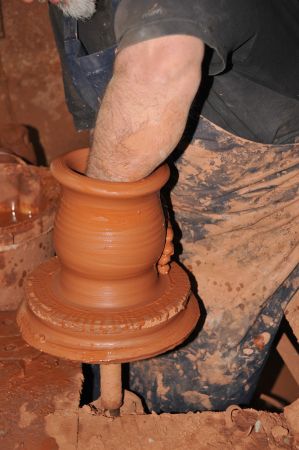 The first ceramic figures are more than 24,000 years old; they come from the Upper Palaeolithic and can often be described as random products that were created over a campfire on loam or clay soil. The oldest known pottery vessels come from the Xianrendong Cave in the People's Republic of China; they arose about 20,000 to 19,000 BC. The oldest evidence for a specific use of ceramic vessels was dated to the beginning of the Jōmon period in Japan, on the basis of vessels that were made between 15,000 and 11,800 years before Christ and were used for cooking sea creatures.
The first ceramic figures are more than 24,000 years old; they come from the Upper Palaeolithic and can often be described as random products that were created over a campfire on loam or clay soil. The oldest known pottery vessels come from the Xianrendong Cave in the People's Republic of China; they arose about 20,000 to 19,000 BC. The oldest evidence for a specific use of ceramic vessels was dated to the beginning of the Jōmon period in Japan, on the basis of vessels that were made between 15,000 and 11,800 years before Christ and were used for cooking sea creatures.
Since the 6th millennium BC The slowly turning potter's wheel was used in the Near East. At the same time, coloured ceramics also emerged and reached their heyday in the following millennia in Mesopotamia, Iran, Asia Minor and Greece. With the invention of the fast rotating potter's wheel around 4000 BC. the production of mass-produced goods began. Glazed pottery has been around since the 3rd millennium BC. known from Mesopotamia and Egypt.
Pottery making was considered a dishonest profession in the Middle Ages
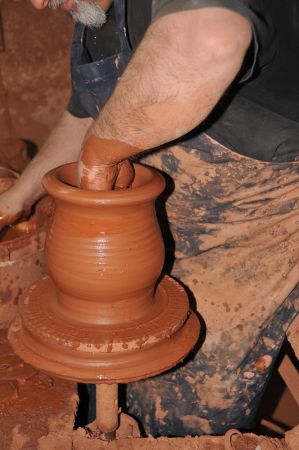 In the Middle Ages, pottery was one of the "dishonest" professions. Dishonest professions were stained with social contempt. “Occupation” is to be understood in a general sense as “a way of earning a living” and not as a regulated occupation requiring formal training. Unlike today, "dishonest" did not mean "fraudulent", but "dishonourable", "dishonourable", without status. The ideas about what constitutes dishonour, which activities are to be counted as dishonest, differed in space and time, so that there cannot be a universally valid catalogue of dishonest ways of earning money.
In the Middle Ages, pottery was one of the "dishonest" professions. Dishonest professions were stained with social contempt. “Occupation” is to be understood in a general sense as “a way of earning a living” and not as a regulated occupation requiring formal training. Unlike today, "dishonest" did not mean "fraudulent", but "dishonourable", "dishonourable", without status. The ideas about what constitutes dishonour, which activities are to be counted as dishonest, differed in space and time, so that there cannot be a universally valid catalogue of dishonest ways of earning money.
Today, modern pottery with high-quality ceramic work has also made a name for itself in the applied arts. Not only functional ceramics, but also ceramic sculptures, reliefs and ceramic jewellery are offered in different techniques such as majolica, fine stoneware, raku ceramics and smoke-fired ceramics.
Shaping techniques in pottery
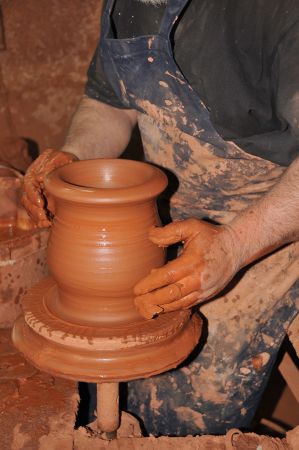 Our two masters had already convinced us with the pottery they had created on the wheel, when they pulled out the lump of clay, which had been rotated quickly, with their hands or with templates to form a rotationally symmetrical vessel while shaping it on the wheel.
Our two masters had already convinced us with the pottery they had created on the wheel, when they pulled out the lump of clay, which had been rotated quickly, with their hands or with templates to form a rotationally symmetrical vessel while shaping it on the wheel.
The next day we were allowed to take part in a pottery course that the masters had set up for interested children. And as part of this course, which will also be offered to schools and kindergartens in the future, the children also learned the basic skills of the craft. They began by forming flakes of clay, which were then placed on top of each other and smeared, known in technical jargon as a construction technique. In the beading technique, thin strands of clay are rolled and layered on top of each other in rings or spirals, then smeared and smoothed. These first works are still too well remembered, because in our school there were handicraft lessons that were almost obligatory linked to clay work. Lessons of this kind are still rather rare in Turkey, which is why the activities of the pottery association are to be rated all the more highly.
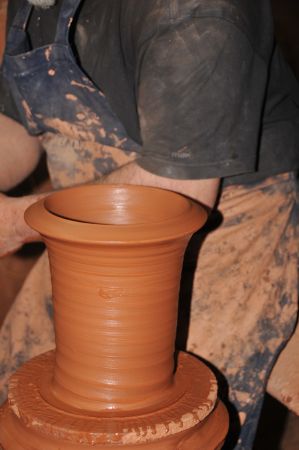 After shaping, the air-dried workpieces are fired and thereby additionally hardened. This requires temperatures from 450 °C to over 1280 °C. At temperatures below 1000 °C, the pottery remains permeable to water, which is why it is called terracotta and is often used to pave paths in the garden or on terraces. The material only starts to become vitrified when it is fired at higher temperatures. Only certain clays can be fired high enough to vitrify; these are especially clinker clay, stoneware clay and, as a special product, porcelain (kaolin). In order to make porous clay vessels impermeable to water and also for aesthetic reasons, low-fired clay vessels are often covered with a glaze.
After shaping, the air-dried workpieces are fired and thereby additionally hardened. This requires temperatures from 450 °C to over 1280 °C. At temperatures below 1000 °C, the pottery remains permeable to water, which is why it is called terracotta and is often used to pave paths in the garden or on terraces. The material only starts to become vitrified when it is fired at higher temperatures. Only certain clays can be fired high enough to vitrify; these are especially clinker clay, stoneware clay and, as a special product, porcelain (kaolin). In order to make porous clay vessels impermeable to water and also for aesthetic reasons, low-fired clay vessels are often covered with a glaze.
Little by little, our knowledge deepened, which, at least according to the masters on site, is said to have led to far more well-known and groundbreaking discoveries:
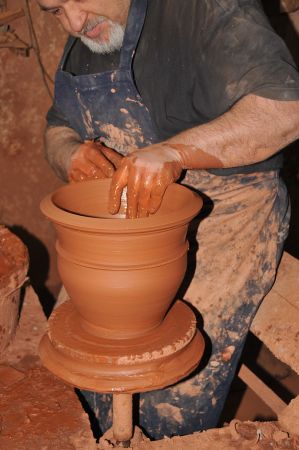 The invention of the potter's wheel probably led to the invention of the wheel about 6,000 years ago.
The invention of the potter's wheel probably led to the invention of the wheel about 6,000 years ago.
In the meantime, the afternoon had progressed well and we felt hungry and thirsty, although there had already been one or the other Çay in the workshop. So the president of the local pottery association, Mr. Ertan Saruhan, took us to eat at a restaurant on the route to Canakkale, after we had seen a huge pottery association store on the way there.
After so many new insights, the description and explanation of our activities as well as the activities of the pottery association followed over dinner. There was great interest in a pottery festival, which could be prepared and planned in the course of this year and then implemented in 2015. There was also a great deal of interest in setting up a student exchange concept and in a town twinning. We reported on the planned encounter and culture festival in Regensburg in October of that year and on the possibilities of a first visit by a small delegation of interested people from Menemen on this occasion.
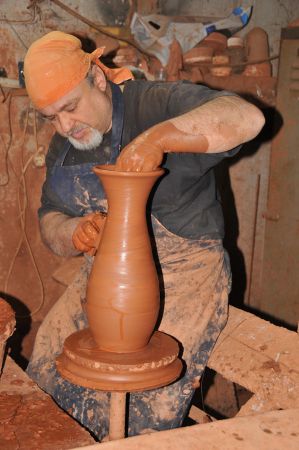 It was already dark when we postponed the conversation, which was really interesting, until the next day, because our "hostel father" was already waiting for us in his garden area, where we were to set up our caravan for the next two days.
It was already dark when we postponed the conversation, which was really interesting, until the next day, because our "hostel father" was already waiting for us in his garden area, where we were to set up our caravan for the next two days.
And how could it be otherwise, this really hospitable family also belonged to the pottery craft association, but they were more artistically active, as we found out the following day. Now we first went into the area of the olive and orchard, where there was a turning opportunity almost at the back of the garden that was big enough for a towing vehicle and caravan, because reverse parking was no longer possible due to the darkness and the narrowness of the gate.
Please read as well:
